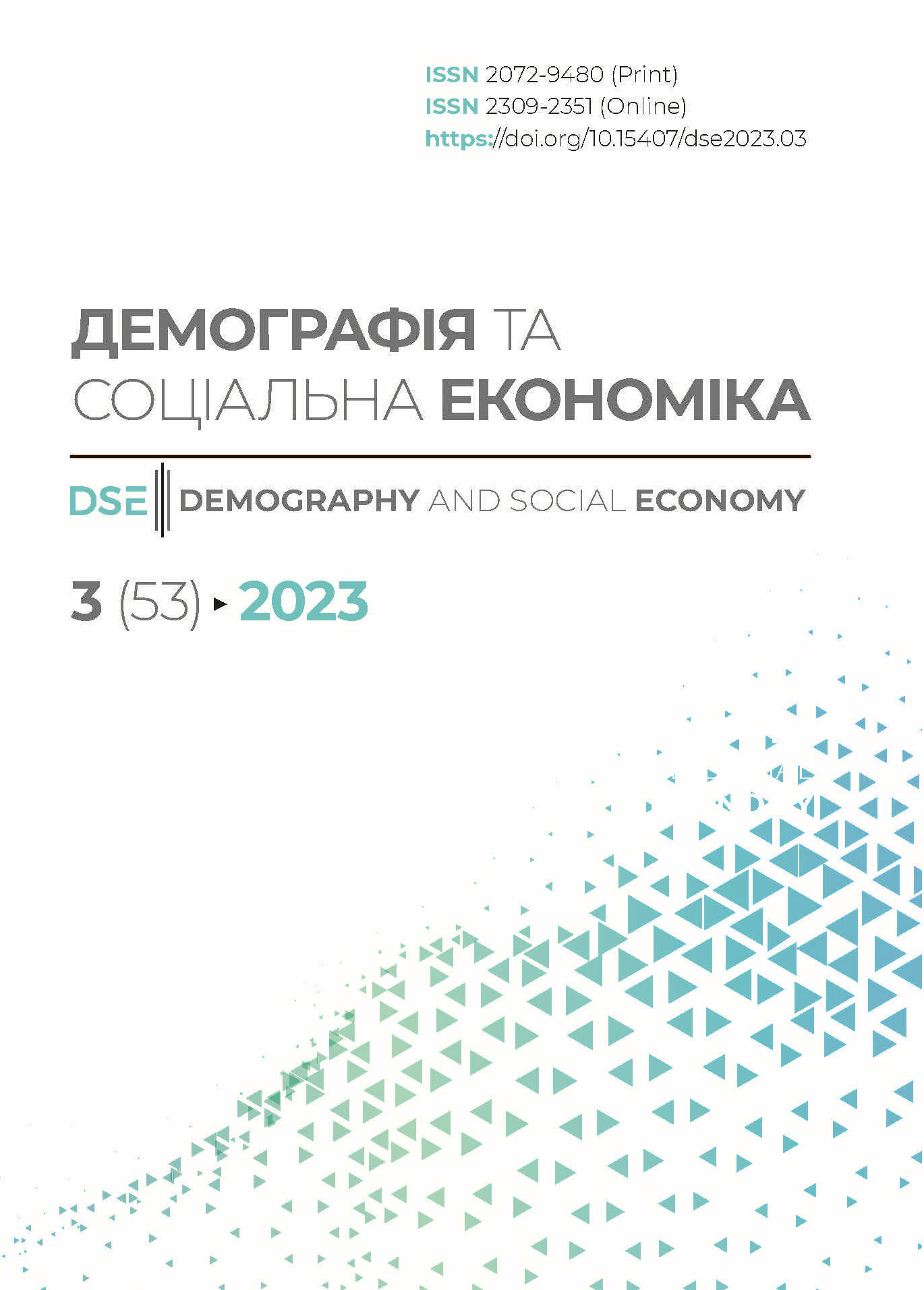REMITTANCES IN UKRAINE DURING THE FULL-SCALE WAR
DOI:
https://doi.org/10.15407/dse2023.03.018Keywords:
remittances, private transfers, international migration, forced migration, Ukraine, transfer behavior, counter-cyclicality of transfers, migrants’ well-beingAbstract
The article is dedicated to the study of the issues related to private money transfers to Ukraine from abroad and in the reverse direction after the onset of a full-scale invasion. The relevance of the research is explained by the dramatic changes in migration behavior of the Ukrainian population as a result of the full-scale attack by the aggressor country and the significant increase in population outflow beyond the country’s borders. As a result, it is necessary to identify the changes in the volumes and patterns of private transfers since these financial flows have been a source of well-being for their recipients and have significantly stimulated the development of the national economy. The aim of the article is to investigate money transfers to Ukraine from abroad and in the reverse direction after the full-scale invasion by the aggressor country. Methods of analysis, synthesis, comparison, generalization, and selective observation were used. The novelty of the research lies in determining the significance of money transfers from Ukrainians during the full-scale war, identifying the resource potential of forced and voluntary migrants for conducting private transfers to Ukraine, and highlighting the theme of outbound financial flows from Ukraine. A full-scale war has led to a noticeable decrease in the overall volume of remittances to Ukraine. This has primarily occurred due to a reduction in the coverage area of data collection, as the aggressor occupied additional territories, and also due to possible changes in the remitters’ transfer behavior. Research has revealed a rapid decrease in the cost of conducting remittances to Ukraine following the onset of the full-scale invasion. Based on empirical data regarding the well-being of forced Ukrainian migrants abroad who left the country after the full-scale invasion, their potential for conducting private transfers to Ukraine is assessed as low. Migrants who left the country before the invasion have more opportunities for making transfers to Ukraine. The research has documented the widespread active use of funds accumulated in Ukraine abroad. This includes personal savings, pensions, and other types of payments, as well as infrequent remittances sent to forced migrants in their host countries.
REFERENCES
- Tkachuk, I. (2017). The Individual at the Core of Scientific Research by Economists. Effective Economics, 12 [in Ukrainian].
- Operational data portal. Ukraine refugee situation (2023). https://data2.unhcr.org/en/situations/ukraine
- State Border Guard Service of Ukraine. Official website (2023). https://dpsu.gov.ua/ [in Ukrainian].
- Migration and social-political attitudes during the war in Ukraine (2022). Gradus research https://gradus.app/uk/open-reports/gradus-eu-wave-12-ua/ [in Ukrainian].
- Attitudes and assessments of Ukrainian refugees (July–August 2022). Razumkov center. https://razumkov.org.ua/napriamky/sotsiologichni-doslidzhennia/nastroi-ta-otsinkyukrainskykh-bizhentsiv-lypen-serpen-2022p [in Ukrainian].
- Mykhalyshyna, D. (2023). What Will Encourage Ukrainian Refugees to Return Home. https://www.epravda.com.ua/publications/2023/03/20/698183/ [in Ukrainian].
- Górny, А. (2023). Between Ukraine and Poland. Ukrainian migrants in Poland during the war. Centre of Migration Research Newsletter, February 2023, № 2(28).
- Jauhiainen, J., Erbsen, H. A., Lysa, O., & Espenberg, K. (2022). Temporary protected Ukrainians and other Ukrainians in Estonia. University of Turku. 142 p. https://www.researchgate.net/publication/364817798_Temporary_protected_Ukrainians_and_other_Ukrainians_in_Estonia_2022
- Life on Pause: Intentions and Prospects of Refugees from Ukraine. Regional Report 2 on Refugee Intentions (September 2022). 24 p. [in Ukrainian].
- Sholomitska, O. (2021). Labor Market of Ukraine, Gender Inequality, and Labor Migration: Quarantine Experience. https://www.epravda.com.ua/columns/2021/01/15/670012/ [in Ukrainian].
- National Bank of Ukraine. Statistics of the External Sector (2023). https://bank.gov.ua/ua/statistic/sector-external
- Russia Occupied 7 % of Ukraine’s Territory – President (2021). Ukrinform. https://web.archive.org/web/20210508170127/https://www.ukrinform.ua/rubric-ato/2644798-rosiaokupuvala-7-teritorii-ukraini-prezident.html [in Ukrainian].
- National Bank of Ukraine (2018). Revised Data on Private Money Transfers to Ukraine for 2015-2017. Department of Statistics and Reporting. Kyiv. https://bank.gov.ua/admin_uploads/article/Remittances %20_2015-2017.pdf?v=4 [in Ukrainian].
- Vargas-Silva, C. (2014). Remittances and the Business Cycle: A Reliable Relationship? https://www.compas.ox.ac.uk/2014/remittances-and-the-business-cycle-a-reliablerelationship/
- Remittances, Countercyclicality, Openness and Government Size (2011). Recherches économiques de Louvain, 4 (vol. 77), 89—114. https://doi.org/10.3917/rel.774.0089
- The World Bank Forecasts the Sharpest Decline in Remittance Volumes in Recent History. The World Bank (2020). https://www.worldbank.org/uk/news/press-release/2020/04/22/world-bank-predicts-sharpest-decline-of-remittances-in-recent-history [in Ukrainian].
- External labor migration of the population of Ukraine (based on the results of a modular sample survey). Statistical Bulletin (2017). Kyiv: State Statistics Service of Ukraine [in Ukrainian].
- The First Days of Full-Scale War: Thoughts, Emotions, Actions. Initial Research Findings. (2022). CEDOS. https://cedos.org.ua/wp-content/uploads/pershi-dni-povnomasshtabnoyivijny-v-ukrayini-2.pdf
- Remittances brave global headwinds (2022). Special Focus: Climate Migration. Migration and Development Brief 37. https://www.knomad.org/sites/default/files/publication-doc/migration_and_development_brief_37_nov_2022.pdf
- Mobrand, E. (2012). Reverse Remittances: Internal Migration and Rural-to-Urban Remittances in Industrialising South Korea. Journal of Ethnic and Migration Studies, 38, 389—411. https://doi.org/10.1080/1369183X.2012.658544
- Pendley, S. C., VanLandingham, M. J., Pham, N. N. & Do, M. (2021). Resilience within Communities of Forced Migrants: Updates and the Path Forward. Journal on Migration and Human Security, 9, 154—164. https://doi.org/10.1177/23315024211038947
- Tucha, O., Spivak, I., Bondarenko, O. & Poharska, O. (2022). The Impact of Ukrainian Migrants on Recipient Countries’ Economies. National Bank of Ukraine. Research. https://bank.gov.ua/admin_uploads/article/Migration_impact_2022-12-15.pdf?v=4 [in Ukrainian].
Downloads
Published
How to Cite
Issue
Section
License
Copyright (c) 2023 Ірина Майданік

This work is licensed under a Creative Commons Attribution-NonCommercial-NoDerivatives 4.0 International License.


